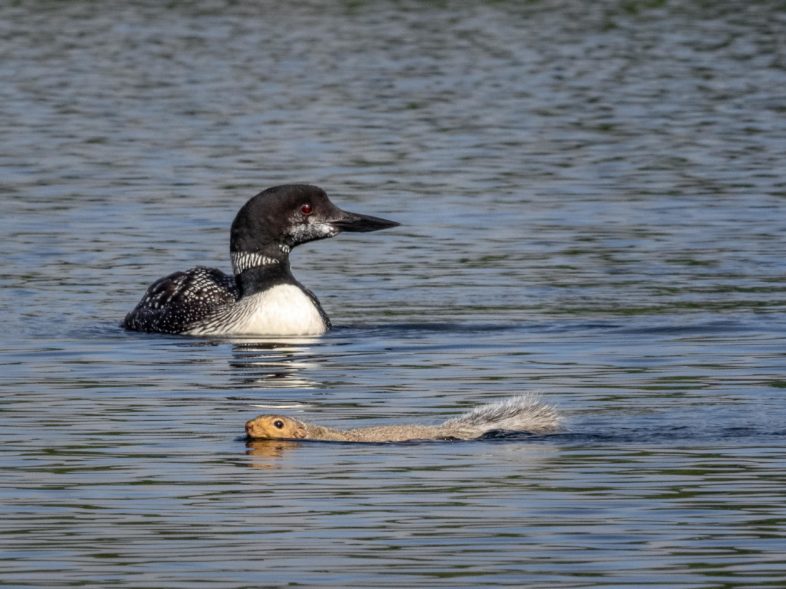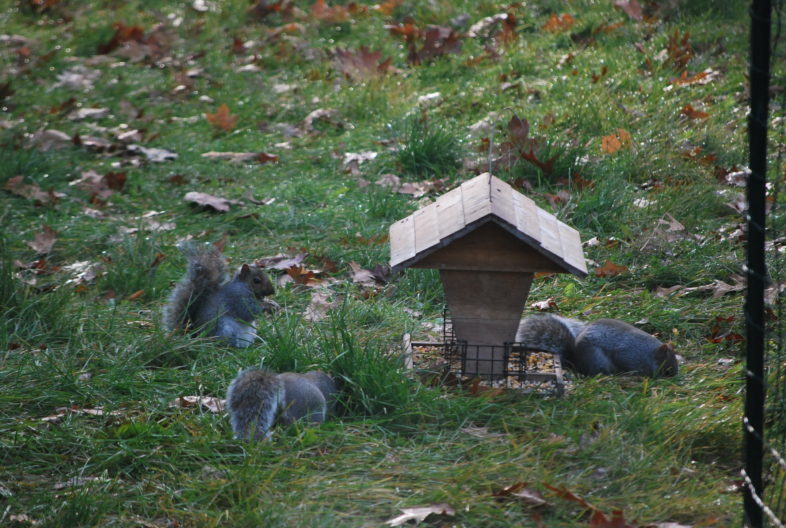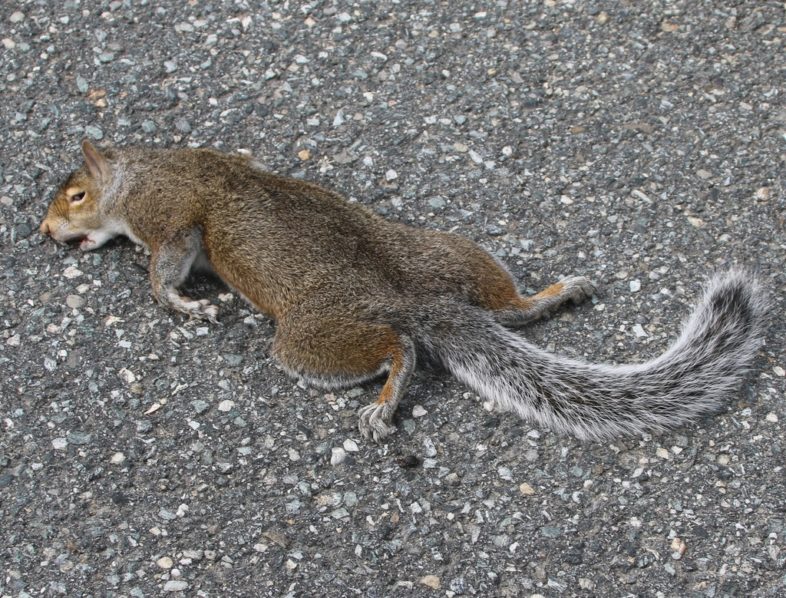
A Common Loon appears to look slightly puzzled as a gray squirrel swims by on Tewksbury Pond in Grafton, NH on 14 September 2018, Photo courtesy of Marc Beerman http://www.oldmanphotography.com/.
Eastern Gray Squirrels continue their phenomenal, dramatic march across the Northeast this autumn. As reported by Kent McFarland in VCE’s Field Guide to September, this species, together with its feisty relative the Red Squirrel, is appearing in droves throughout the region, apparently in response to actual or perceived food shortages. Last fall’s super-bountiful crop of cones, seeds and nuts — referred to as mast — enabled seed predators like squirrels and mice to crank out the kids. But now, with mast at “normal,” if not meager, levels across the region, there are simply far too many animals to survive in a given patch of habitat. The result? A mass and seemingly chaotic exodus, most notably of Eastern Gray Squirrels. Food is scarce, and they’re on the move.
Some more adventurous squirrels are taking to our waterways, swimming across rivers and ponds, even attempting to cross Lake Champlain. No one has witnessed anything quite like this in recent memory, though there is historic precedent, as Kent noted published reports of “great hordes” of transient squirrels back in the early and mid-1800s. This late summer and autumn, the airwaves have been rife with accounts of wayward squirrels. From birding listservs to local newspapers like the Valley News to big-city broadsheets like the Boston Globe, people are taking notice.
Sadly, what most people are noticing is less the spectacle of a stunning, living mass dispersal, but the many thousands, if not millions, of squirrels that are ending up as roadside carcasses. I recently gained some personal perspective on this. Most people know that I like to count things. I’ll confess that my latest, albeit short-term, enumeration fetish involves road-killed squirrels. I doubt I’ll ever do this again, but on a recent trip to and from southern Maine, I decided to count squirrel carcasses along my interstate route. I divided up my “census” into four sections, and here’s what I found on my two travel dates, 21 and 24 September. Nearly all animals tallied (at least those I could confidently identify) were gray squirrels.
- I-91 Hanover-Norwich to I-89 exits — 22, 15
- I-89 from W. Lebanon to I-93 — 149, 112
- Route 101 from I-93 to I-95 — 349, 455
- I-95: north side of Piscataqua bridge to Wells-Sanford exit — 114, 188
Surprisingly, there seem to be very few scavengers like American Crows or Turkey Vultures opportunistically feeding on the abundant roadkill bounty. One has to wonder if we will see a “cascading effect” through the regional food web during the months ahead, as raptors and scavengers potentially benefit (and increase in number) from a surfeit of available food, live and dead. Certainly, bird feeders are likely to host large squirrel populations this winter, to the delight of some observers and the dismay of others!

Eastern gray squirrels bulking up at a bird feeder, a sight that will likely become familiar to many in the northeastern U.S. during the approaching colder months. © Bruce Stone, flickr
For now, the Northeast’s current mass squirrel dispersal, despite its grisly consequences along our roadways, is yet one more example of the unendingly fascinating, dynamic ecological links that characterize our natural world.


Loon and grey squirrel swimming together…..that’s one for (your) books! Thanks, Chris….enjoy Monhegan….best time of the year!
Chris, this is Gretchen and Michael and we want to know HOW you count squirrels driving 65-70 mph on the interstate? We’re it’s scientific but pray tell ! You’re the best!
Wow! I had noticed this and attributed the squirrel bounty to a good last year last season. But I had not idea about the migration. Thanks for the story!
Here in Toronto Ontario Canada we have Blacks, Greys and now Fox Squirrels. They are somewhat more territorial than the smaller ones and a bit more aggressive.
Thanks Chris. I can verify the high roadkill survey results on Rte 101. I think the concrete barrier in the median tends to elevate the mortality odds substantially in many locations along that corridor. I am curious though as to why particularly on roads such as 101 that you see one you are likely to see 10-20. Are there squirrel “game trails” or pathways? Do they leave a scent that attracts another to cross a roadway in the same place? Or are they now traveling in packs due to climate change or something? 🙂
With that number killed I wonder what the total population is? Bigger than we might have thought?
Chipmunks, too?
Thank you Mr. Rimmer for vindicating my predilection to counting, and to observing the proliferation and demise of our furry friends. I recently traveled I-91 from exit 10- south to exit 3. I started keeping count of the number of roadkill but gave up after a period ten miles as the traffic was too heavy. I estimated the average number to be approximately 1.5/mile.
I have also noticed a lack of scavenging by our feathered clean-up crews. Most interesting.
I live in Wilmington, VT and run a small farm. I’ve noticed an abundance of grey squirrels, even a black squirrel in my area. The grey squirrels have replaced the previous dominant red squirrel. Can you explain why the red squirrels that were heavily populating this area as of mid-summer have virtually disappeared?
The newly arrived grey squirrels are very bold and aggressive due to hunger. On the farm there’s always some scattered corn and the grey squirrels are not shy about coming into the barn or chicken coop to feast. I’ve never had squirrels frequenting my chicken coop. I always thought the hens and roosters were a deterrent, but not with this group of squirrels. Have the grey squirrels driven the red squirrels away?
On September 30 when driving back from Maine to the Adirondacks, I started noticing an enormous carnage of gray squirrels, especially on Route 101 between I-95 and I-93. I started counting and for almost that entire stretch of highway there were between 15-20 dead squirrels per lane mile on just the northbound lanes. The total increased to 30/mile when there were concrete barriers at overpasses preventing the squirrels from reaching the median and forcing them to face the heavy traffic again. The oak-dominated roadside forests must have fostered many gray squirrels over the past year and now they are dispersing in search of food, as predicted.